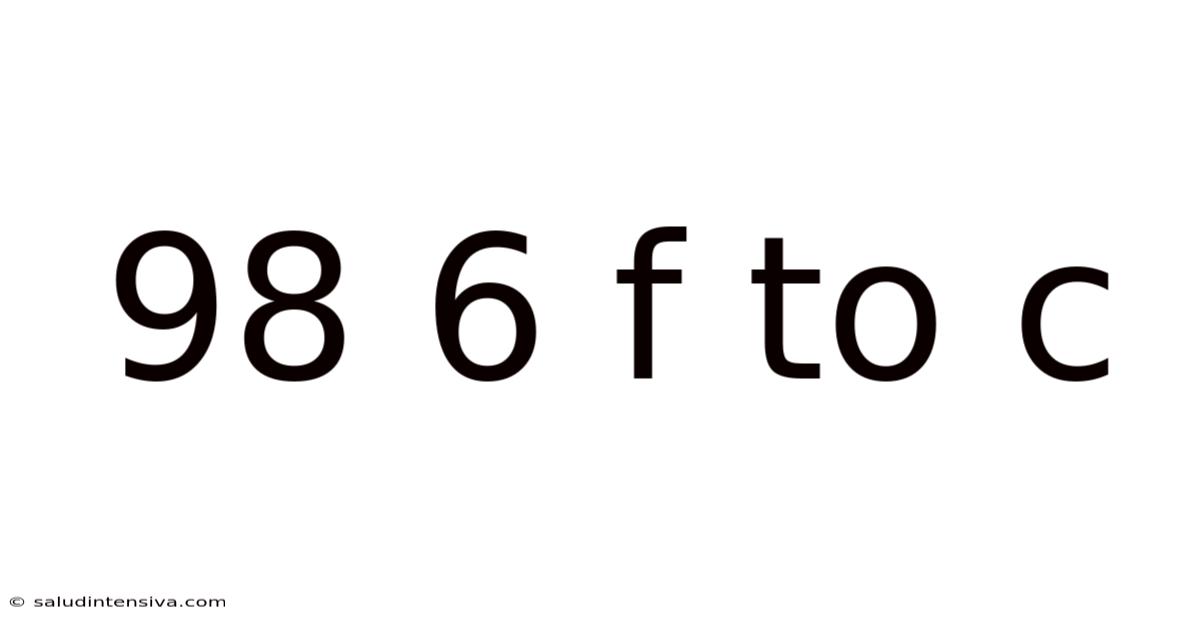98 6 F To C
saludintensiva
Sep 22, 2025 · 5 min read

Table of Contents
Decoding 98°F to °C: A Comprehensive Guide to Fahrenheit and Celsius Conversions
Understanding temperature conversions between Fahrenheit (°F) and Celsius (°C) is crucial in various fields, from everyday life to scientific research. This comprehensive guide will delve into the conversion process of 98°F to °C, providing a detailed explanation, practical examples, and addressing frequently asked questions. We will explore the historical context of these scales and provide you with the tools to confidently convert temperatures between the two systems. Learning this skill empowers you to understand weather reports, cooking instructions, and even medical information accurately.
Understanding Fahrenheit and Celsius Scales
Before jumping into the conversion of 98°F to °C, let's briefly review the history and properties of both scales.
-
Fahrenheit (°F): Developed by Daniel Gabriel Fahrenheit in the early 18th century, this scale defines the freezing point of water at 32°F and the boiling point at 212°F, at standard atmospheric pressure. It's predominantly used in the United States and a few other countries.
-
Celsius (°C): Also known as the centigrade scale, it was developed by Anders Celsius in the 18th century. This scale sets the freezing point of water at 0°C and the boiling point at 100°C, again at standard atmospheric pressure. It's the most widely used temperature scale globally and is the standard in science.
Converting 98°F to °C: The Formula and Process
The conversion between Fahrenheit and Celsius is a straightforward mathematical process. The formula for converting Fahrenheit to Celsius is:
°C = (°F - 32) × 5/9
Let's apply this formula to convert 98°F:
-
Subtract 32: 98°F - 32°F = 66°F
-
Multiply by 5/9: 66°F × 5/9 = 36.67°C
Therefore, 98°F is equal to 36.67°C.
Practical Applications and Examples
Understanding this conversion is valuable in numerous contexts:
-
Medicine: Normal human body temperature is often given as 98.6°F. Using the conversion, we find this is approximately 37°C. This knowledge is essential for interpreting medical readings and understanding health information.
-
Cooking: Many recipes, particularly those originating from countries using the Celsius scale, provide cooking temperatures in °C. Knowing how to convert allows for accurate cooking and baking. For example, a recipe calling for 175°C oven temperature can be converted to roughly 347°F.
-
Weather: International weather reports often use Celsius. Converting between the two scales allows you to understand weather forecasts regardless of the reporting system. A temperature of 25°C, for instance, is equivalent to 77°F.
-
Science and Engineering: Scientific experiments and engineering projects often require precise temperature control, necessitating accurate conversions between Fahrenheit and Celsius.
Beyond the Basics: A Deeper Dive into Temperature Scales
While the conversion formula is straightforward, it's beneficial to understand the underlying principles. The difference between the boiling and freezing points of water on the Fahrenheit scale (212°F - 32°F = 180°F) and the Celsius scale (100°C - 0°C = 100°C) highlights the different scale gradations. The factor 5/9 in the conversion formula accounts for this difference. Each degree Celsius represents a larger temperature change than a degree Fahrenheit.
There are other temperature scales as well, such as Kelvin (K), which is the absolute temperature scale. The Kelvin scale starts at absolute zero, the theoretical point where all molecular motion ceases. The relationship between Celsius and Kelvin is:
K = °C + 273.15
Frequently Asked Questions (FAQ)
Q1: Why are there two different temperature scales?
A1: Historically, different scales developed independently. Fahrenheit's scale was based on reference points readily available at the time, while Celsius later provided a more logical and widely adopted system.
Q2: Is 98.6°F the exact normal human body temperature?
A2: While 98.6°F (37°C) is a commonly cited average, normal body temperature can vary slightly between individuals and throughout the day. Factors like activity level and time of day can influence readings.
Q3: Can I use a calculator or online tool for conversion?
A3: Yes, many online calculators and apps provide instant conversion between Fahrenheit and Celsius. However, understanding the formula is beneficial for independent calculations and better grasp of the concept.
Q4: How do I convert Celsius to Fahrenheit?
A4: The reverse conversion formula is: °F = (°C × 9/5) + 32
Q5: What are some common mistakes to avoid when converting temperatures?
A5: Common errors include forgetting to subtract 32 before multiplying by 5/9 (when converting from Fahrenheit to Celsius) or mistakenly inverting the fraction 5/9 or 9/5. Careful attention to the formula and order of operations is essential.
Conclusion: Mastering Temperature Conversions
Mastering the conversion between Fahrenheit and Celsius, especially converting familiar temperatures like 98°F, equips you with a valuable practical skill. The process is simple yet profoundly useful in various aspects of life, from everyday tasks to specialized fields. Understanding the underlying principles of the different scales and the conversion formula empowers you to confidently interpret and utilize temperature information accurately. Whether you're following a recipe, interpreting a weather report, or checking your body temperature, the ability to seamlessly switch between Fahrenheit and Celsius adds a layer of competence and understanding to your knowledge base. Remember to practice the conversion process regularly to solidify your understanding and enhance your problem-solving skills. This seemingly simple skill opens doors to a more precise and informed understanding of the world around us.
Latest Posts
Latest Posts
-
200cm In Ft And Inches
Sep 22, 2025
-
16 Hours From 8 Pm
Sep 22, 2025
-
18 Min Mile In Mph
Sep 22, 2025
-
4 To The 4 Power
Sep 22, 2025
-
10 Yard Concrete Truck Cost
Sep 22, 2025
Related Post
Thank you for visiting our website which covers about 98 6 F To C . We hope the information provided has been useful to you. Feel free to contact us if you have any questions or need further assistance. See you next time and don't miss to bookmark.